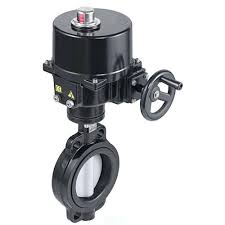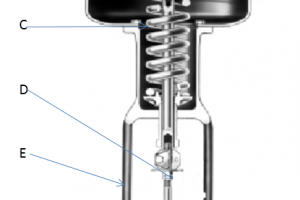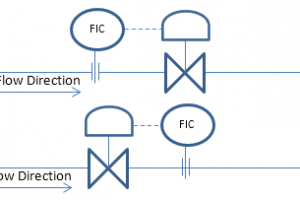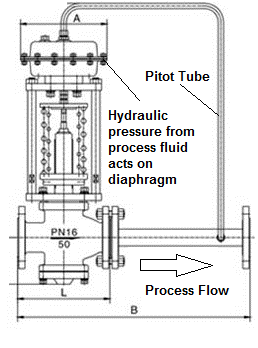A motor-operated valve (MOV) is a type of valve that uses an electric motor to open or close the valve mechanism. It is commonly used in industrial applications, particularly in process plants, power plants, and oil and gas facilities. The motor provides the necessary torque to actuate the valve, allowing for precise control over the flow of fluids or gases.
Table of content:
1. What is motor operated valve?
2. Applications of motor operated valves
3. Types of motor operated valves
4. Key differences between control valves and motor operated on/off valves
5. Typical Instrument Datasheet - Motor Operated Valve
What is motor operated valve?
Motor Operated Valve (MOV) is an important item of Plant & Piping system. These valves are generally of large size and are used for different applications such as Pump discharge etc.
Motor Operated Valves are often called as On-Off valves as the motors serve the purpose of fully opening or fully closing valves in pipelines. For example, cooling water lines, process pipelines where controlling of fluid is not required, motor operated valves can be used to fully allow or fully stop the fluid flow. These valves are not used for throttling purposes as they serve mainly On-Off service application.
Motor operated valves can be of various types e.g. Gate/ Ball/ Butterfly etc. with actuator control. An electric motor is mounted on the valve and geared to the valve stem so that when the motor operates the valve will open or close. For this MOV, motor operated with actuator control from local panel or, from control room is required.
Applications of motor operated valves
Whenever frequent operation is required: Motor-operated valves (MOVs) are often used in applications where valves need to be opened and closed frequently. This could be due to the nature of the process, such as in a chemical plant where valves need to be opened and closed to control the flow of chemicals. Or it could be due to the location of the valve, such as in a remote location where it is not practical for a person to be present to operate the valve manually.
Valves located in remote, inaccessible or hazardous places: Motor operates valves can also be used in applications where valves are located in remote, inaccessible, or hazardous places. For example, MOVs can be used to control valves that are located in a confined space where it is not safe for a person to enter. Or MOVs can be used to control valves that are located in a hazardous environment, such as a flammable or explosive atmosphere.
Motorised control valve / Motor operated valves are usually used for full open and full close applications. This is because MOVs are typically powered by electric motors, which can provide a lot of torque to quickly and easily open or close a valve. However, there are some applications where MOVs can be used for position control. For example, MOVs can be used to control the flow of a fluid in a process where the flow rate needs to be precisely controlled.
Types of motor operated valves
Motorised control valve can be classified into three types. However it must be noted that the main application of motorised valves are for flow control and flow isolation.
- Open/close valves - used to automate manual open close valves Examples include, pump discharge / suction valves, boiler feed water isolation valves, drum vent valves, product line valves etc.
- Inching valves - used were some degree of control. Example a gradual opening and closing is required, applications include, reflux lines, boiler start up vent, boiler IBD valves, boiler main steam valves etc.
- Precision flow valves - this is a precision inching valve, in inching valve the motor operates in steps configured in the controller, e.g. 5%, 10% opening steps. In precision flow valves, a continuous control is enabled by the use of proper feedback from the field to the controller which is not usually found in other motor operated valves. An example is steam injection valve / water injection valves used in GT for Nox control.
Different types of motor operated valves are defined based on how those valves are actually opened or closed and what applications they are used for. Check the given post for more detailed understanding types of motor operated valves.

Key differences between control valves and motor operated on/off valves
- Response time: Control valves have a faster response time than motorized valves. This is because control valves use an analog control element, which can move more quickly than a digital control element. Motorized valves, on the other hand, use a digital control element, which is slower to move.
- Control element: Control valves usually have an analog control element, while motorized valves have a digital control element. An analog control element is a continuous variable, such as a voltage or current. A digital control element is a discrete variable, such as a binary signal.
- Applications: Control valves can be used for any type of control, including pressure control, flow control, and temperature control. Motorized valves are usually (if not always) used for flow control. This is because motorized valves are able to open and close more quickly than control valves.
- Control loop: Control valves are usually used in closed loop control, while motorized valves are predominantly open loop. In closed loop control, the valve is controlled by a feedback signal. This feedback signal tells the valve how far to open or close in order to maintain a desired setpoint. In open loop control, the valve is not controlled by a feedback signal. Instead, the valve is opened or closed to a predetermined position.
- Precision control: Control valves are used for precision control. This is because control valves have a faster response time and a more precise control element than motorized valves. Motorized valves are not usually used for precision control because they are slower to respond and less precise.
Typical Instrument Datasheet - Motor Operated Valve
The datasheet of motor operated valve along with Requisition form is then sent to suppliers/vendors who later on submit technical bids for respective MOV’s / valves.
Typical datasheet for the MOV is discussed in the given post.






